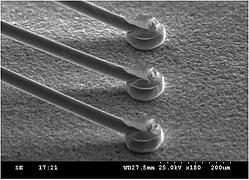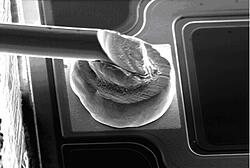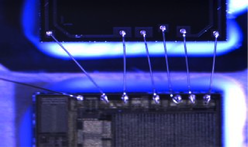High-reliability wire bonding traditionally required the addition of a security bond over the stitch—or second bond—of each ball bonded wire. While this method does create a much higher reliability wire bond, it can at times lead to yield and other issues. It also requires forward bonding the wire every time.
If the package you are forward bonding to offers less than favorable conditions, you may be forced to use slightly higher than normal bond functions (higher force and/or ultrasonic power) to ensure that the second bond sticks. You then come back to that second bond and place the security bond over the heel of the wire resulting with a very high-reliability wire. That slight over bonding process can sometimes lead to a lifted stitch you may or may not be able to rework, depending on your packaging requirements.
 The 8000 Wire Bonder / Ball (Stud) Bumper is capable of producing flat-topped ball bumps (stud bumps) and bond normal ball-stitch wires in the same program with the same wire and same capillary, providing many options and flexibility in microelectronic packaging. For example, the first bond of a ball-bonded wire is very easy to bond, and almost always has a very high process capability on an IC or package. The second bond of a ball-bonded wire is more challenging—even with near perfect materials—and has a much lower process capability. On forward-bonded wires (IC to package), the second bond is generally placed on less than optimal material conditions. The weak link of a ball-bonded wire is, therefore, the second bond as it is more difficult to bond and is usually bonded to poor materials compared to the first bond. Stand-off stitch bonding greatly strengthens forward-bonded wires, generating ultra high-reliability wire bonds!
The 8000 Wire Bonder / Ball (Stud) Bumper is capable of producing flat-topped ball bumps (stud bumps) and bond normal ball-stitch wires in the same program with the same wire and same capillary, providing many options and flexibility in microelectronic packaging. For example, the first bond of a ball-bonded wire is very easy to bond, and almost always has a very high process capability on an IC or package. The second bond of a ball-bonded wire is more challenging—even with near perfect materials—and has a much lower process capability. On forward-bonded wires (IC to package), the second bond is generally placed on less than optimal material conditions. The weak link of a ball-bonded wire is, therefore, the second bond as it is more difficult to bond and is usually bonded to poor materials compared to the first bond. Stand-off stitch bonding greatly strengthens forward-bonded wires, generating ultra high-reliability wire bonds!
With the capability to mix ball bumps with normal wires, you can place a flat topped bump on the second bond location. The ball bonds well to even less-than-favorable materials. When you then forward bond (ball on IC) stitch on the stand-off bump, you end up with a ball on both ends of the wire. The second bond diffuses nearly effortlessly into the flat-topped bump. When done automatically, you see a slight reduction in overall throughput due to the addition of the stand-off bump, but the reliability of the first level interconnect dramatically increases. And we can even increase reliability further.
When forward bonding, the bonder must “kick-back” the wire above the first bond so that it can form a consistent loop profile. This type of motion in itself does not cause a reduction in reliability, but it does if it is done just above the bond in the Heat Affected Zone (HAZ) above the first wire bond. The 8000 Wire Bonder has the option of forward bonding or reverse bonding.
Stand-off stitch bonding can be performed forward or reverse. When reverse bonding, you put the flat topped bump on the IC and then place the first bond of a normal ball-bonded wire on the package surface (loop up) and stitch off (second bond) on top of the flat-topped bump. This method generates two excellent benefits: no work hardening of the wire during looping in the HAZ zone, and it generates a very low loop profile above the IC. In a sense, this method of bonding emulates wedge bonding as it creates very low loops. You can even bond to MIL-STD-883 legally from die to die.
When reverse bonding, you put the flat topped bump on the IC and then place the first bond of a normal ball-bonded wire on the package surface (loop up) and stitch off (second bond) on top of the flat-topped bump. This method generates two excellent benefits: no work hardening of the wire during looping in the HAZ zone, and it generates a very low loop profile above the IC. In a sense, this method of bonding emulates wedge bonding as it creates very low loops. You can even bond to MIL-STD-883 legally from die to die.
 In either case, stand-off stitch bonding delivers measurable improvements in the strength of the resultant wire with the vast majority of destructive tests breaking mid-span of the wire. Nothing is better than mid-span breaks in any wire bonded interconnect—the ultra high-reliability wire bond.
In either case, stand-off stitch bonding delivers measurable improvements in the strength of the resultant wire with the vast majority of destructive tests breaking mid-span of the wire. Nothing is better than mid-span breaks in any wire bonded interconnect—the ultra high-reliability wire bond.
----
Bradley Benton
Western North America Regional Sales Manger
Palomar Technologies